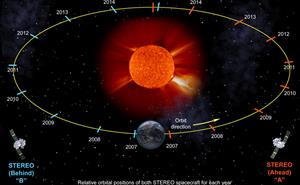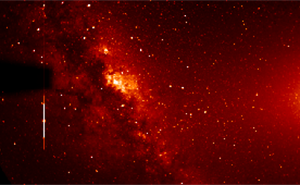From solar orbits drifting away from Earth, the RAL-led Heliospheric Imagers are the first instruments to image and track Earth-directed CMEs from the side, enabling a better prediction of arrivals at Earth.
RAL Space Involvement
Development and operation of the Heliospheric Imagers (HI; RAL Principal Investigator) – wide-angle imagers that image solar ejecta in the inner heliosphere
Subject
Solar physics/ STP
Main Objectives
To advance the understanding of the three-dimensional structure of the Sun's corona.
Launch Date
26 Oct 2006
Partners
University of Birmingham, UK, Centre Spatial de Liege, Belgium, Naval Research Laboratory, USA
Further Project Information
Overview
The Sun ejects vast clouds of ionized gas into space; these clouds are known as coronal mass ejections (CMEs). Each CME may carry 1,000,000,000 tonnes of gas into space at speeds that can approach 2000 km/s. When they engulf Earth, CMEs can disrupt power, navigation, communication and satellite control systems. Despite their importance, scientists don't fully understand the origin or evolution of CMEs, nor their structure or extent in interplanetary space.
 NASA’s twin spacecraft STEREO mission, launched in October 2006, is providing a totally new perspective on solar phenomena by imaging CMEs and other solar features from two viewpoints simultaneously. The two near-identical spacecraft are in Earth-like orbits around the Sun, displaced from one another, with the STEREO-A spacecraft orbiting the Sun ahead of the Earth and STEREO-B orbiting the Sun behind the Earth. Both spacecraft look at the Sun itself, and also the region of interplanetary space between the Sun and Earth-like distances (1 Astronomical Unit; 1 AU). The unique twin-platform view allows stereoscopic imaging of the Sun and the structure of CMEs, enabling scientists to study their fundamental nature and origin.
NASA’s twin spacecraft STEREO mission, launched in October 2006, is providing a totally new perspective on solar phenomena by imaging CMEs and other solar features from two viewpoints simultaneously. The two near-identical spacecraft are in Earth-like orbits around the Sun, displaced from one another, with the STEREO-A spacecraft orbiting the Sun ahead of the Earth and STEREO-B orbiting the Sun behind the Earth. Both spacecraft look at the Sun itself, and also the region of interplanetary space between the Sun and Earth-like distances (1 Astronomical Unit; 1 AU). The unique twin-platform view allows stereoscopic imaging of the Sun and the structure of CMEs, enabling scientists to study their fundamental nature and origin.
It is, in fact, the RAL Space-led Heliospheric Imagers (HIs) on STEREO that observe that region of interplanetary space between the Sun and 1 AU, using wide-angle telescopes. The STEREO/HI instruments are being used to identify and track CMEs as they propagate through interplanetary space, with particular focus on those that are directed towards the Earth.
When combined with data from near-Earth spacecraft, and observatories on the ground, the STEREO data will enable scientists to identify and track in 3D those CMEs that propagate towards Earth and investigate their effects on Earth’s environment, as well as studying the processes on the Sun associated with their launch. In addition to leading the STEREO/HI instruments, all of the imaging instruments aboard both STEREO spacecraft use a CCD-based camera system developed by RAL Space.
For further information:
STEREO Heliospheric Imager
 The Heliospheric Imager (HI) is a wide-angle visible-light imaging system for the detection of coronal mass ejection (CME) events in interplanetary space and, in particular, of events directed towards the Earth.
The Heliospheric Imager (HI) is a wide-angle visible-light imaging system for the detection of coronal mass ejection (CME) events in interplanetary space and, in particular, of events directed towards the Earth.
The protective covers, or doors, of the HI instruments were opened at the end of 2006 and early in 2007 on the two spacecraft revealing an unprecedented view of the space between the Sun and the Earth. Within the first months of operation, HI had observed the dark-side of the Moon, several CMEs, asteroids and, in the very first images received from one of the instruments a spectacular view of comet McNaught.
Since then, in addition to observing and cataloging many more CME, the HI instruments have made a number of spectacular observations and discoveries, including:
- The impact of a CME on Venus and the interpretation of its effects by comparing HI images with data received from spacecraft in orbit around the planet
- The collision of a CME with a comet, resulting in the stripping off (or "disconnection") of the comet's tail
- The discovery of the element iron, in atomic form, in the tail of a comet
- The imaging for the first time of the very faint optical emission associated with so-called Corotating Interaction Regions (CIRs) in interplanetary space, where fast-flowing Solar wind catches up with slower wind regions
The HI instrument has been developed by a UK-led consortium which includes the Centre Spatial de Liege, Belgium, and the Naval Research Laboratory, USA.
UK STEREO Team
Instrument Scientist: Dr Chris Eyles
Project Scientist: Dr Jackie Davies
Data/Software Manager: Steve Crothers
UKSSDC Manager: Matthew Wild
For more information please contact: RAL Space Enquiries
